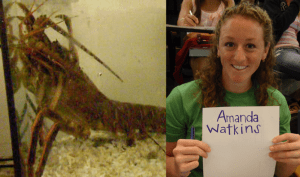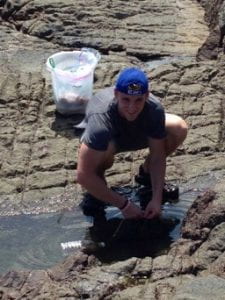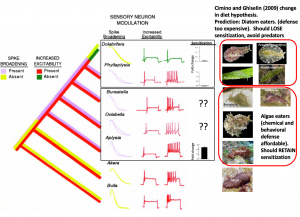The sea hare, Aplysia californica, is a widely used model species for understanding the neural mechanisms of learning and memory. Earlier research on multiple sea-hare species by Dr. Wright discovered strong evidence for evolutionary changes in neural mechanisms underlying behavioral learning and memory phenomena (24, 27, 30). As might be expected, these evolutionary changes in mechanisms were largely consistent with evolutionary changes in behavioral learning phenotypes (25, 27, 30, 31). The MIB lab sought an adaptive ecological explanation for these changes but realized that, in spite of high-profile research on the mechanisms of learning (e.g., here), our understanding of the adaptive value of sea-hare learning was nearly nil.
One particular form of learning, sensitization, refers to an increase in reflex withdrawal for 30 min to several days after strong traumatic stimuli. Prior to the MIB-lab’s research, painful artificial stimuli (e.g., electric shock) were used in the laboratory to produce this simple form of learning, yet no natural stimulus was known that might produce sensitization of Aplysia. The MIB lab demonstrated that
a. the California spiny lobster attacks sea hares in the wild (37),
*click on image to view video
b. these attacks cause robust sensitization of sea hares in the lab (35, Nature “Lobster Shock”),
*click on image to view video
c. these attacks cause similar neural changes as observed after electric shock (36)
These observations suggested that sensitization might very well be part of a predator defense system. Interestingly, our evolutionary studies identified two different sea hares (Dolabrifera and Phyllaplysia) that had lost the sensitization phenotype. How could they possibly get along without this apparently important predator defense? We reasoned that these two species might compensate by increasing their level of chemical defense across evolution (virtually all sea slugs have at least some chemical defense) they deployed against predators. MIB-labbies Kim Takagi and Nadia Ono were surprised to find that both Dolabrifera and Phyllaplysia are nearly devoid of chemical protection (34). How can they survive? Alex Himstead and Dr. Wright traveled down to Panama to study the foraging behavior of one of these species, Dolabrifera. This sea hare hides under boulders and in cracks when not foraging: Alex and Dr. Wright found a strikingly precise initiation of foraging behavior within minutes of the dropping tide falling below the pool (thus blocking access of subtidal predators such as fish and lobster to the foraging sea hares; 38). In short, rather than defend itself from predators, Dolabrifera appears to avoid them. The other learning-challenged sea hare, the cryptically colored Phyllaplysia, strikingly matches the surf grass upon which it lives, elevated above crab and lobster predators; avoidance appears to be the evolutionary strategy here as well.
Alex Himstead in Dolabrifera tidepools
It is difficult to imagine what circumstances would select for this wholesale change in strategy from a distasteful sea hare whose behavior is radically altered after surviving an attack, to relatively palatable sea hares, which precisely avoid predators instead of surviving, and learning from, attacks.
What ecological conditions might have triggered these radical changes in adaptive behavior? Both sensitization-free sea hare species have also changed their diet from chemically complex red algae, which provides a rich source of anti-predator chemicals, to diatoms, which provide very little protection (see Cimino & Ghiselin, 2009, Proc. Cal. Acad. Sci., 60(10), 175-422). Without the chemical protection from a red-algal diet, sea hares cannot cheaply chemically deter and behaviorally adjust (via sensitization) to predator attack; both adaptations are lost. Instead, these sea hares develop a habitat/foraging schedule that effectively avoids predators.
This hypothesis predicts that two additional diatom feeders (2 different species of the Petalifera genus; above figure upper right) should also lack chemical and cognitive defenses. Conversely, three as yet untested species (Stylocheilus, Bursatella, and Dolabella) should all retain the chemical and sensitization phenotype observed in Aplysia. Stay tuned!




